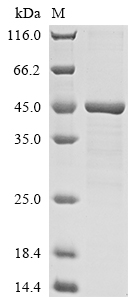Recombinant Human Histone H2AX (H2AFX) is produced in E. coli and includes the complete protein sequence from amino acids 1 to 143. The protein carries an N-terminal 6xHis-GST tag that helps with purification, reaching purity levels above 85% as confirmed by SDS-PAGE. This product is designed for research purposes only and appears to offer a dependable choice for different experimental setups.
Histone H2AX represents a variant within the histone H2A protein family and seems to play an essential role in how cells respond to DNA damage. It participates in DNA repair processes, especially when DNA double-strand breaks occur. When damage happens, H2AX gets phosphorylated, which likely marks the damage site and brings in repair proteins. Studying this protein may be critical for grasping how genomic stability works and how cells react to DNA damage.
Potential Applications
Note: The applications listed below are based on what we know about this protein's biological functions, published research, and experience from experts in the field. However, we haven't fully tested all of these applications ourselves yet. We'd recommend running some preliminary tests first to make sure they work for your specific research goals.
Human Histone H2AX is a core histone protein that requires precise folding, proper dimerization with H2B, and specific tertiary structure for its functional activity in nucleosome assembly and DNA damage response. The E. coli expression system can produce soluble histone proteins but may not support optimal folding for proper nucleosome incorporation without refolding procedures. The large N-terminal 6xHis-GST tag (∼32 kDa combined) is significantly larger than the H2AX protein itself (143 aa, ∼15 kDa), causing severe steric interference that will disrupt the protein's ability to form proper heterodimers with H2B and incorporate into nucleosomes. The probability of correct folding with functional nucleosome assembly activity is extremely low.
1. Antibody Development and Validation
This application has severe limitations. While antibodies can be generated, the immune response will primarily target the large foreign GST tag rather than the H2AX protein. Antibodies may not recognize the native, properly folded H2AX in nucleosomal context.
2. Biochemical Characterization and Biophysical Analysis
Basic biophysical analysis can be performed but will not reflect native H2AX structure. The GST tag will dominate all physical properties, and results will describe an artificial construct rather than the physiological histone protein.
Final Recommendation & Action Plan
This GST-tagged H2AX expressed in E. coli is unsuitable for functional histone studies due to the extreme size disparity between the tag (32 kDa) and the protein (15 kDa). The GST tag is more than twice the size of H2AX itself, making all structural and functional studies biologically meaningless. Applications 1 and 2 have severe limitations and will not provide insights into native H2AX biology. For reliable H2AX research, use tag-free histone proteins expressed in systems that support proper folding and dimerization, and employ refolding protocols for nucleosome assembly studies.




